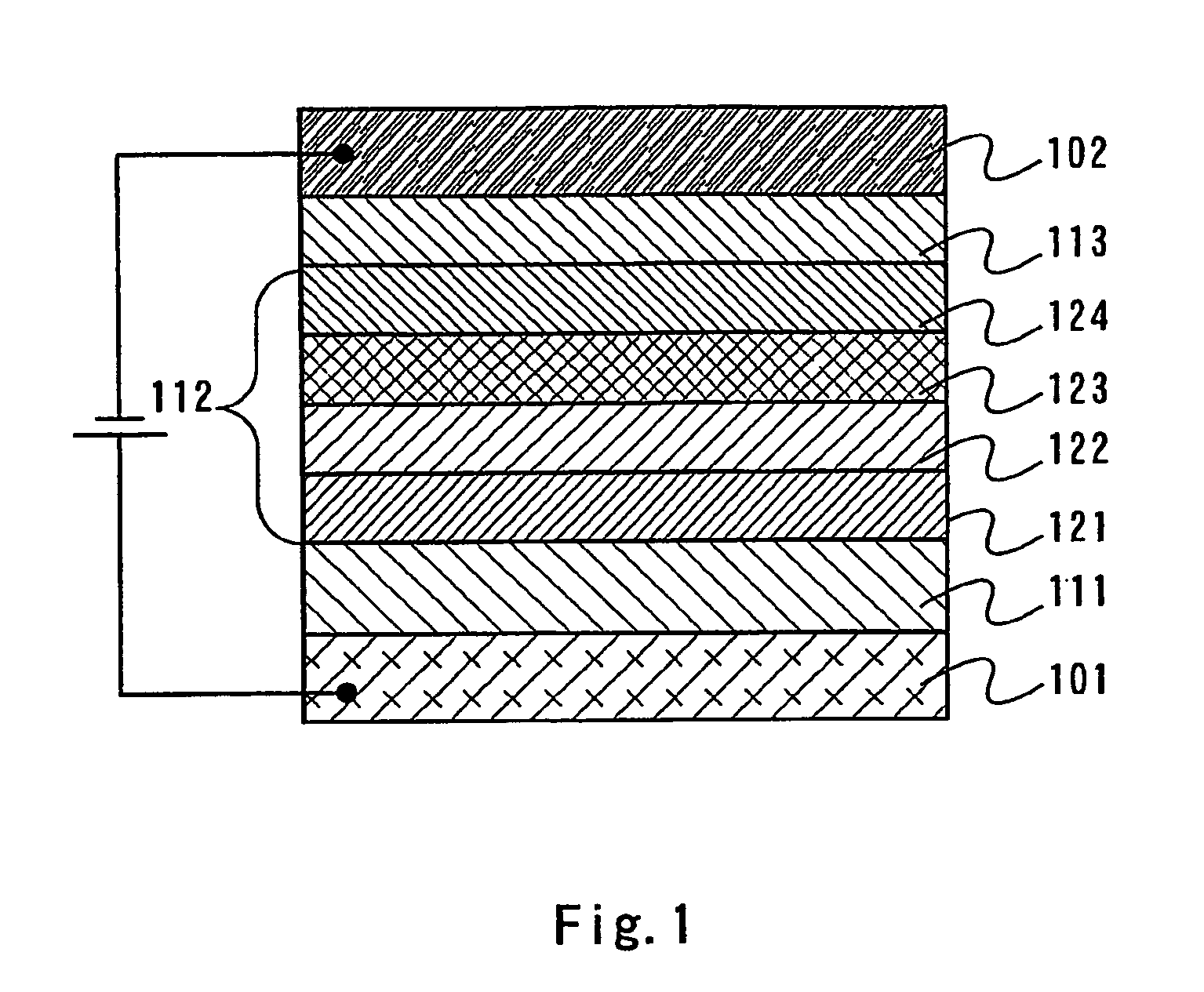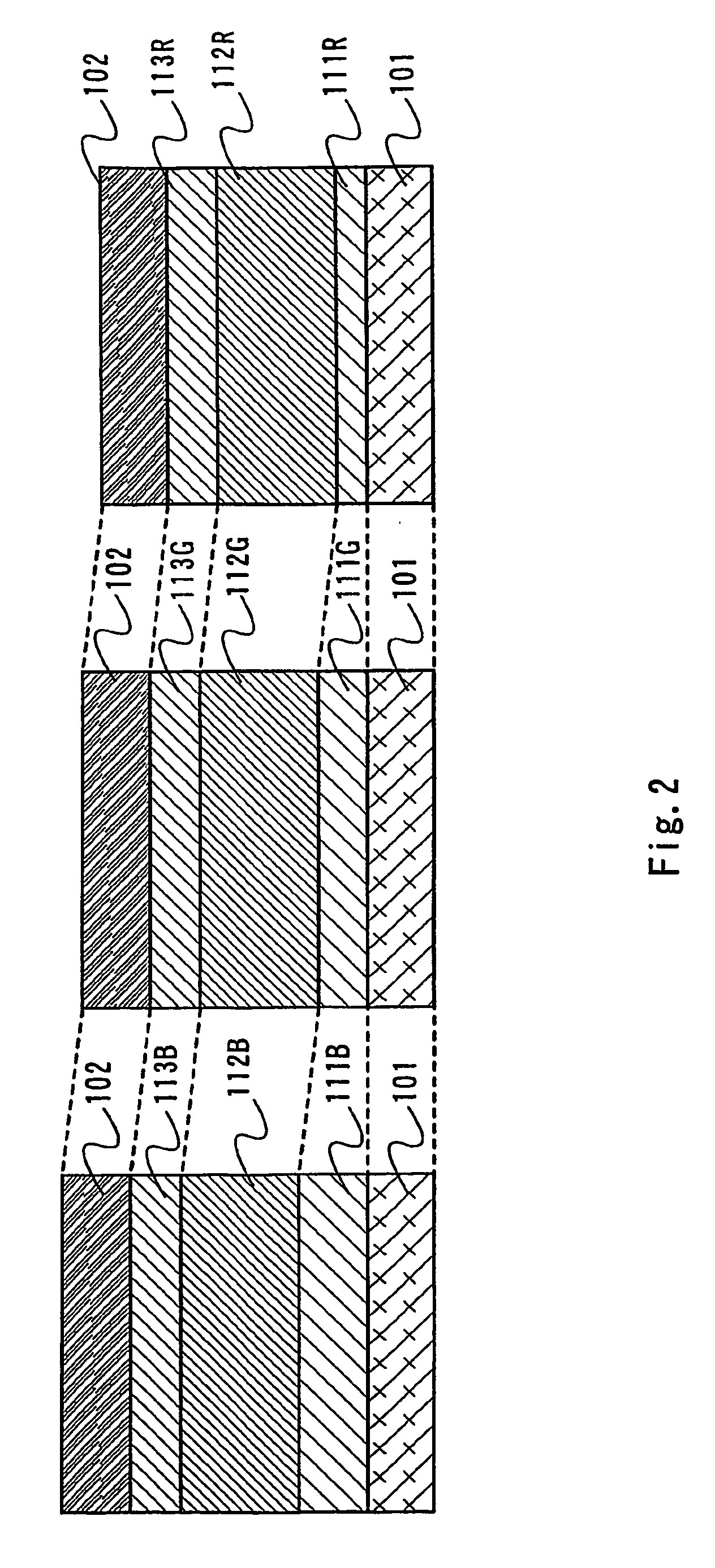Light emitting device
a technology of light-emitting devices and light-emitting elements, which is applied in the direction of electroluminescent light sources, organic semiconductor devices, thermoelectric devices, etc., can solve the problems of low light-emitting efficiency and low light-emitting efficiency, and achieve enhanced light-emitting efficiency, low light-emitting efficiency, and enhanced light-emitting efficiency
- Summary
- Abstract
- Description
- Claims
- Application Information
AI Technical Summary
Benefits of technology
Problems solved by technology
Method used
Image
Examples
embodiment mode 1
[0043]Embodiment Mode 1 describes a structure of a light-emitting element.
[0044]As shown in FIG. 1, a light-emitting element of the present invention includes a first electrode 101 and a second electrode 102 that are opposed to each other, and a first layer 111, a second layer 112 and a third layer 113 are stacked in this order over the first electrode 101. In such a light-emitting element, holes are injected into the second layer 112 from the first layer 111 and electrons are injected into the second layer 112 from the third layer 113, when a voltage is applied to the light-emitting element such that a potential of the first electrode 101 are higher than that of the second electrode 102. The holes and electrons are recombined in the second layer 112 to excite a light-emitting substance. The excited light-emitting substance emits light when returning to the ground state.
[0045]It is one feature of such light-emitting elements that the thickness of at least one of the layers except th...
embodiment mode 2
[0058]Embodiment Mode 2 describes a structure of a light-emitting element which is different from that of Embodiment Mode 1.
[0059]As shown in FIG. 15, a light-emitting element shown in this embodiment mode includes the first electrode 101 and the second electrode 102 that are opposed to each other, and the first layer 111, the second layer 112, the third layer 113 and a fourth layer 128 that are sequentially stacked over the first electrode 101. One feature of the light-emitting element is to have the fourth layer 128. The fourth layer 128 can be formed with the same material as that of the first layer 111. Other structures are the same as those of Embodiment Mode 1 and thus, the description thereof is omitted.
[0060]When the fourth layer 128 is provided, damages to underlayers in forming the second electrode 102 can be reduced.
[0061]The thickness of the fourth layer 128 is made different depending on each light-emitting element emitting each emission color. Consequently, the decreas...
embodiment mode 3
[0065]Embodiment Mode 3 describes a structure in which the thickness of any of layers is made different in a light-emitting device including a color filter.
[0066]As shown in FIG. 16, color filters 115R, 115G and 115B are provided in regions that are to exhibit red (R), green (G) and blue (B) that are different in optical characteristics, respectively. The color filters can be formed using a known material by a screen printing method, a droplet discharging method or the like. FIG. 16 shows the case where the color filters 105R, 105G and 105B are provided on the second electrode side 102 (on the emission side), and in this case, the second electrode 102 needs to be light-transmitting.
[0067]The structure of the light-emitting element is as follows: the first layers H1R, H1G and H1B, the second layers 112R, 112G, and 112B, the third layers 113R, 113G and 113B, and the second electrode 102 are formed sequentially over the first electrode 101. Since each color is generated by the color fi...
PUM
 Login to View More
Login to View More Abstract
Description
Claims
Application Information
 Login to View More
Login to View More - R&D
- Intellectual Property
- Life Sciences
- Materials
- Tech Scout
- Unparalleled Data Quality
- Higher Quality Content
- 60% Fewer Hallucinations
Browse by: Latest US Patents, China's latest patents, Technical Efficacy Thesaurus, Application Domain, Technology Topic, Popular Technical Reports.
© 2025 PatSnap. All rights reserved.Legal|Privacy policy|Modern Slavery Act Transparency Statement|Sitemap|About US| Contact US: help@patsnap.com



